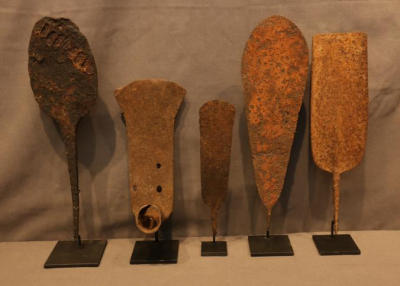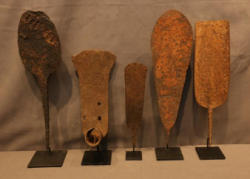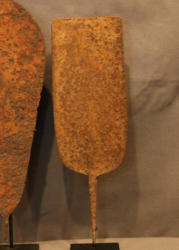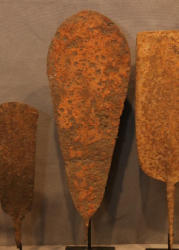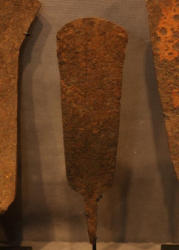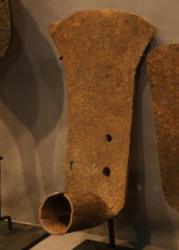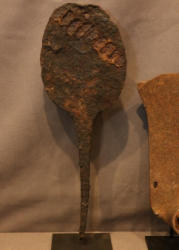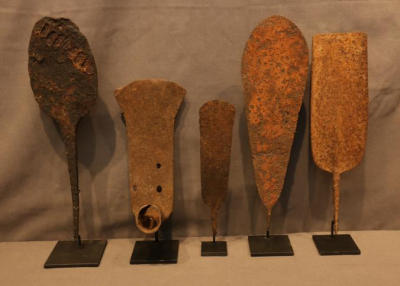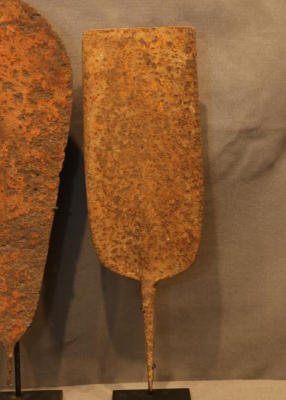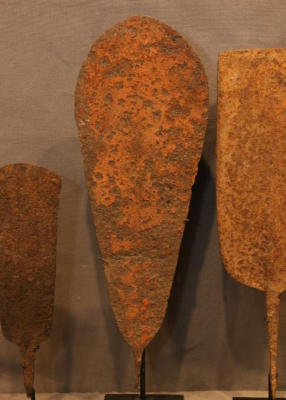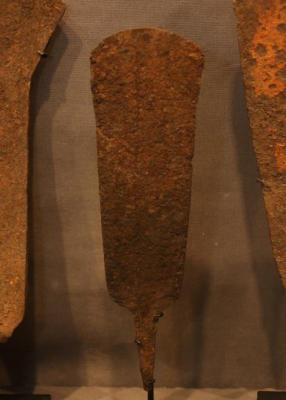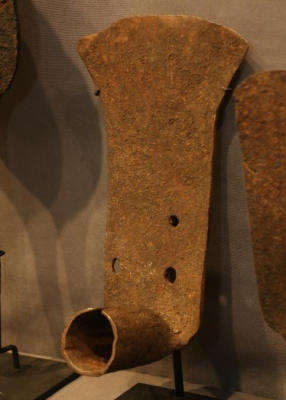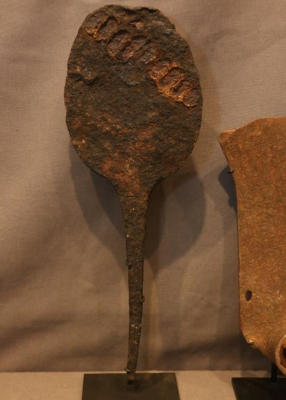Items located in Pleasant Valley, NY. Items include Faro, the water genie puppet from Mali; West African double gongs; Ode-lay society head crest mask from Sierra Leone; African sculptures, figurines, masks, textiles, ceremonial robes, copper rod currency, and more.
AFRICAN ART COLLECTION OF MARY SUE AND PAUL PETER ROSEN
Mary Sue and Paul Peter Rosen have collected African art for over thirty years, making nine trips to Africa to study the art in its cultural setting. The Rosens have published three African art books, curated more than ten exhibitions from their collection, and have given public lectures about African art and culture. They have donated art from their collection to various institutions including the Newark Museum, Temple University in Philadelphia, the SMA Fathers African Art Museum in Tenafly, New Jersey, and the African American Research Library in Fort Lauderdale, Florida.
Payment is due by Monday, April 1 at 1PM.
Pickup in Pleasant Valley, NY must be completed by Monday, April 1 at 3PM.
All lots sold as is, where is. There is a 15% Buyers Premium for all lots purchased. Payment methods include cash, MC, Visa, Discover or good check. You can make credit card payment online by going to your Member Area and selecting your invoice.
*NOTE* Shipping is available on all items.
AFRICAN ART COLLECTION OF MARY SUE AND PAUL PETER ROSEN
Mary Sue and Paul Peter Rosen have collected African art for over thirty years, making nine trips to Africa to study the art in its cultural setting. The Rosens have published three African art books, curated more than ten exhibitions from their collection, and have given public lectures about African art and culture. They have donated art from their collection to various institutions including the Newark Museum, Temple University in Philadelphia, the SMA Fathers African Art Museum in Tenafly, New Jersey, and the African American Research Library in Fort Lauderdale, Florida.
Payment is due by Monday, April 1 at 1PM.
Pickup in Pleasant Valley, NY must be completed by Monday, April 1 at 3PM.
All lots sold as is, where is. There is a 15% Buyers Premium for all lots purchased. Payment methods include cash, MC, Visa, Discover or good check. You can make credit card payment online by going to your Member Area and selecting your invoice.
*NOTE* Shipping is available on all items.
?EMBLEMS OF POWER. ASAFO FLAGS FROM GHANA? BY M.S. AND P.P. ROSEN IS ONLY AVAILABLE FROM THE AUTHORS AT ppr2001@med.cornell.edu PRICE POSTPAID IN US IS $25.00; OUTSIDE US POSTPAID $35.00.
Auction Info
Items located in Pleasant Valley, NY. Items include Faro, the water genie puppet from Mali; West African double gongs; Ode-lay society head crest mask from Sierra Leone; African sculptures, figurines, masks, textiles, ceremonial robes, copper rod currency, and more.
AFRICAN ART COLLECTION OF MARY SUE AND PAUL PETER ROSEN
Mary Sue and Paul Peter Rosen have collected African art for over thirty years, making nine trips to Africa to study the art in its cultural setting. The Rosens have published three African art books, curated more than ten exhibitions from their collection, and have given public lectures about African art and culture. They have donated art from their collection to various institutions including the Newark Museum, Temple University in Philadelphia, the SMA Fathers African Art Museum in Tenafly, New Jersey, and the African American Research Library in Fort Lauderdale, Florida.
Payment is due by Monday, April 1 at 1PM.
Pickup in Pleasant Valley, NY must be completed by Monday, April 1 at 3PM.
All lots sold as is, where is. There is a 15% Buyers Premium for all lots purchased. Payment methods include cash, MC, Visa, Discover or good check. You can make credit card payment online by going to your Member Area and selecting your invoice.
*NOTE* Shipping is available on all items.
AFRICAN ART COLLECTION OF MARY SUE AND PAUL PETER ROSEN
Mary Sue and Paul Peter Rosen have collected African art for over thirty years, making nine trips to Africa to study the art in its cultural setting. The Rosens have published three African art books, curated more than ten exhibitions from their collection, and have given public lectures about African art and culture. They have donated art from their collection to various institutions including the Newark Museum, Temple University in Philadelphia, the SMA Fathers African Art Museum in Tenafly, New Jersey, and the African American Research Library in Fort Lauderdale, Florida.
Payment is due by Monday, April 1 at 1PM.
Pickup in Pleasant Valley, NY must be completed by Monday, April 1 at 3PM.
All lots sold as is, where is. There is a 15% Buyers Premium for all lots purchased. Payment methods include cash, MC, Visa, Discover or good check. You can make credit card payment online by going to your Member Area and selecting your invoice.
*NOTE* Shipping is available on all items.
?EMBLEMS OF POWER. ASAFO FLAGS FROM GHANA? BY M.S. AND P.P. ROSEN IS ONLY AVAILABLE FROM THE AUTHORS AT ppr2001@med.cornell.edu PRICE POSTPAID IN US IS $25.00; OUTSIDE US POSTPAID $35.00.
Categories:
FIVE EXAMPLES OF AFRICAN HOE CURRENCY. Because the hoes used by different African tribes tend to have forms that are nearly as unique as their face masks, they are often named after the tribe itself. In general, the shape and weight of the blade was adapted to local farming conditions where it was used. Most hoes where functional tools which could also be used as currency, but in some instances a non-functional form was created to be used exclusively as currency. Each example in this lot was hand forged and is on a custom base. (A) Tsonga people, Swaziland. Objects of material culture from Swaziland are rarely found in Western private or museum collections. This hoe was forged from locally smelted iron and is believed to date from the mid-to-late 1800s. Iron. H 18in. (B) Ngelima and Mbole people, Congo. This thin feather-shaped blade, an example of currency derived from a hoe form, would be too fragile to actually use for farming. It comes from the region of the Ituri and Lomani Rivers where it was called “jembe” or “dupa”. As late as 1894, 3 “jembe” were required as payment by the Belgian colonial administration for “hut” taxes. The explorer David Livingston reported paying 3 “jembe” to have his party of 36 men and a number of animals ferried across Lake Bemba in the Congo. Iron. H 15in. (C) Source uncertain. Feather-shaped hoe strengthened by a central ridge. Iron. H 11in. (D) Chamba people, Nigeria. Reportedly from Kafancham village. Iron. H 14in. (E) Source uncertain. Unusual form with a socket for the handle. Forged from a single piece of iron. H (blade) 10in.
More Details
FIVE EXAMPLES OF AFRICAN HOE CURRENCY. Because the hoes used by different African tribes tend to have forms that are nearly as unique as their face masks, they are often named after the tribe itself. In general, the shape and weight of the blade was adapted to local farming conditions where it was used. Most hoes where functional tools which could also be used as currency, but in some instances a non-functional form was created to be used exclusively as currency. Each example in this lot was hand forged and is on a custom base. (A) Tsonga people, Swaziland. Objects of material culture from Swaziland are rarely found in Western private or museum collections. This hoe was forged from locally smelted iron and is believed to date from the mid-to-late 1800s. Iron. H 18in. (B) Ngelima and Mbole people, Congo. This thin feather-shaped blade, an example of currency derived from a hoe form, would be too fragile to actually use for farming. It comes from the region of the Ituri and Lomani Rivers where it was called “jembe” or “dupa”. As late as 1894, 3 “jembe” were required as payment by the Belgian colonial administration for “hut” taxes. The explorer David Livingston reported paying 3 “jembe” to have his party of 36 men and a number of animals ferried across Lake Bemba in the Congo. Iron. H 15in. (C) Source uncertain. Feather-shaped hoe strengthened by a central ridge. Iron. H 11in. (D) Chamba people, Nigeria. Reportedly from Kafancham village. Iron. H 14in. (E) Source uncertain. Unusual form with a socket for the handle. Forged from a single piece of iron. H (blade) 10in.
High Bid:
$60.00 – gaithaus
Auction Type: One Lot
Quantity: 1
Bidding has closed on this lot

